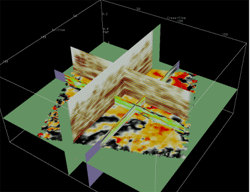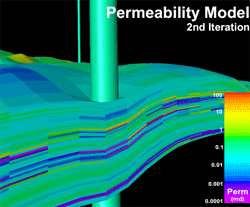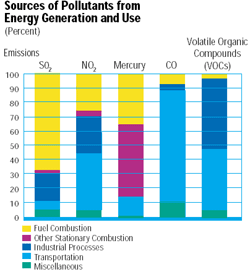
KU Energy Research Center (KU ERC) established in 1991 is administered by two Co-Directors working with an Executive Director and a campus advisory board with a mission to facilitate cross-disciplinary energy research across the KU campus. KU ERC provides direct funding (from successful grants and contracts submitted through the center) to develop innovative ideas and collaborations with industry, academic, and government partners. While small in size, KU ERC has supported 30 start-up projects since 1996 through the Energy Research and Development Grant program (ERDG) that has resulted in over $2.5 million in external funding of projects. The grants program is driven by funds made available to the ERC on returned overhead from successful external grants and contracts are submitted through the ERC.
Areas of Emphasis
Petroleum Reservoir Systems |
Improved Petroleum Recovery |
Energy Databases |
Energy and the Environment |
Alternative Energy |
Basic Energy Research |
Public policy analysis and technology transfer are essential activities of each of these programs. Effective communication with those outside the university is critical to maintaining visibility and relevancy of KU’s energy program. The role of the Center is to stimulate, strengthen, and promote programs in basic energy research, conventional and alternative energy supply, and energy consumption including efficiency and conservation. Opportunities are pursued to facilitate collaboration among researchers and departments, and provide a visible link of energy programs across campus and the region.
Interdisciplinary projects have been focused on the Tertiary Oil Recovery Project (TORP www.torp.ku.edu), Chemical and Petroleum Engineering (C&PE www.cpe.engr.ku.edu), and the Kansas Geological Survey (KGS www.kgs.ku.edu). Participation in the KU ERC program also includes the Geography, Political Science, Environmental Studies, Department of Chemistry, Physics and Astronomy, and Architectural Engineering. Seed funds totaling over $138k from the ERC have supported 24 research projects since 1996 that have generated substantial amounts of new externally funded research.
Policy Statement
The ERC desires to enhance ongoing projects and to extend its affiliation to other energy-related programs on campus that encompass energy supply, both conventional and renewable, and energy consumption including efficiency and conservation and basic energy science. We envision new opportunities to stimulate, strengthen and promote interdisciplinary programs in keeping with trends in external funding opportunities, facilitate collaboration among researchers and departments, and provide a visible link of energy programs across campus.
A mechanism to stimulate new energy research is through the use of indirect costs returned to KU ERC to provide "seed funds" for new and promising research. All energy-related projects are encouraged to consider submission of proposals through the ERC. An ERC campus advisory board oversees the use of the "seed funds."
The indirect costs from funded grants submitted through the ERC originate from an agreement with the KU Center for Research (KUCR) (www.research.ku.edu/kucr/policy/ facr.shtml). Proposals intended to be submitted through the KU ERC should indicate to KURC that the KU ERC is to receive 10% of the returned overhead on the internal cover sheet that is returned to KUCR. This will not affect the crediting of research to department(s) or the PIs, nor the distribution of funds to the Deans, departments, or PI. PIs and Department Heads need to notify and remind KUCR of this arrangement at time that the proposal is submitted.
As stated by KUCR
Ten percent (10%) of the indirect costs (IDC) generated by the project will be returned to the principal investigator's college, school or research center/unit based on his/her appointment. If the investigator has appointments in more than one school, college, or research unit, then allocations will be made proportionately. For multiple investigator projects, the ten percent (10%) IDC return will be allocated among the principal investigator and co-investigators based on the credit allocation specified by the researchers.
If the project is assigned to a research center or other non-academic unit, then an additional four percent (4%) of the IDC will be returned to the assigned unit… If no research center/unit is assigned, then the PI will receive four percent (4%) of the IDC.
Milestones
1991 |
|
|---|---|
1992 |
|
1993 |
|
1994 |
|
1995 |
|
1996 |
|
1997 |
|
1999 |
|
2000 |
|
2001 |
|
2002 |
|
2004 |
|
Recent Accomplishments
- Contracts at the KU ERC for energy-related research have increased steadily over the last five years and awards have remained steady in the last three years. Since 2001 total expenditure from externally funded contracts was approximately $4 million and indirect costs (IDC) nearly $1 million.
- The KU ERC has realized strategic success in directing significant and focused seed funds to new researchers to develop new external funded projects in energy related research. This growing component of the ERC’s portfolio is outside the sphere and mandate of traditional ongoing energy projects at the Geological Survey and TORP. An investment of $137,907 dollars of seed funds during FY1996 through FY2004 has generated in excess of $600,000 of total grant expenditures and $110,000 of IDC.
- Proposals submitted through KU ERC and funded in 2004 thus far include:
- Integrated Subsurface Processing of Landfill Gas and Carbon Sequestration:
- Newly awarded (July ’04) collaborative project with Oak Ridge National Lab, Deffenbaugh Industries and Kansas City LFG, LLC - – D. Newell, PI, Kansas Geological Survey, $172,393 (as proposed). http://www.kgs.ku.edu/General/Personnel/nop/DaveNewell.html
- Using Biosurfactants Produced from Agricultural Process Waste Streams to Improve Oil Recovery in Fractured Carbonate Reservoirs, newly funded (July ’04) – – J. Liang, Chemical and Petroleum Engineering, $560,000 (as proposed). http://www.cpe.engr.ku.edu/faculty/liang.shtml
- Improved Geologic and Engineering Models of Midcontinent Fracture and Karst-Modified Reservoirs Using New 3-D Seismic Attributes, newly funded (July ’04) – - S. Nissen, Kansas Geological Survey in collaboration with University of Houston, $799,926 (as proposed). snissen@kgs.ku.edu
- Evaluating the Influence of Pore Architecture and Initial Saturation on Wettability and Relative Permeability in Heterogeneous, Shallow-Shelf Carbonates (July ’04) -- A. Byrnes and S. Bhattacharya, Kansas Geological Survey, $220,220 (as proposed). abyrnes@kgs.ku.edu
- A patent has been applied for a new form of building insulation involving phase change material. Research facilitated by seed funding provided by KU ERC. -- M. Medina, Civil, Environmental, and Architectural Engineering, www.saud.ku.edu/mariom/mario.htm.
- Other developments facilitated by funding from KU ERC’s Energy Research Development Grant Program include:
- World's first combined topographical and surface ionic activity map of a proton conducting membrane – T.V. Nguyen, Chemical and Petroleum Engineering, http://www.cpe.engr.ku.edu/faculty/nguyen.shtml
- New initiative for biorenewable resources for energy production supported by NSF, and international collaboration in fuel cells research –S. Williams, Chemical and Petroleum Engineering, www.cpe.engr.ku.edu/faculty/stagg-williams.shtml
- The ERC has facilitated collaboration between the Kansas Geological Survey (KGS), Tertiary Oil Recovery Project, petroleum, and the ethanol industry over the past four years leading to recent implementation of a pilot carbon-dioxide tertiary oil recovery project in Hall-Gurney Field near Russell, Kansas. – A. Byrnes, Kansas Geological Survey, and P. Willhite, Chemical and Petroleum Engineering, www.kgs.ku.edu/CO2
- Related to the carbon-dioxide project is “Linked Energy Systems” -- Co-generation, Ethanol Production and CO2 Enhanced Oil Recovery: Model for Environmentally and Economically Sound Linked Energy Systems – M. Dubois, Kansas Geological Survey, www.kgs.ku.edu/PRS/Poster/2002/2002-6

- The Hall-Gurney Field CO2 pilot study provides the framework for another contract with DOE -- acquisition of multi-million dollar state-of-the-art 4-D seismic image monitoring at the pilot project to further evaluate the progress of the carbon-dioxide flood and evaluate the potential to utilize this technology in other national carbon sequestration programs, R. Miller, Kansas Geological Survey, http://www.kgs.ku.edu/Geophysics/4Dseismic/index.html

- Facilitate collaborations between states and industrial partners over the past three years to develop state-of-the-art energy-related web applications:
- KGS and five states developed real-time access of information related to carbon sequestration including characterization of sources and potential sinks for carbon dioxide (CO2), the later particularly focused on utilization of CO2 in petroleum reservoirs (MIDCARB -- www.midcarb.org).
- NATional CARBon Sequestration Database and Geographic Information System (NATCARB), national partnership funded by DOE, administered by Kansas Geological Survey, T. Carr -- www.natcarb.org
- Kansas Energy Information Network (KEIN) (http://www.kansasenergy.org/kein.htm) provides a clearinghouse for information on fossil energy, energy conservation, and renewable energy activities in the state. The site also provides the means to disseminate information on the new 2004 state energy plan led by KGS efforts and pursuit of policies to address new and underutilized forms of energy in Kansas. KEIN site has assisted in dissemination of information related to State Energy Resources Coordination Council (SERCC) (http://www.kansasenergy.org/) and the high visibility role of the University in energy policy and technology.

- Geo-Engineering Modeling through INternet Informatics (GEMINI) launched in October 2003 has 12 Java application tools that can be used to analyze well, leases, and fields saved as projects that can be shared with collaborators on the web. Standalone Java analysis tools are now available from the website including PVT (pressure, volume, temperature) and material balance calculators, gridding and mapping, LAS viewer, production plots for lease and field data. -- L. Watney, J. Doveton, J. Victorine, Kansas Geological Survey, GEMINI -- www.kgs.ku.edu/Gemini
- Energy Technology Transfer has been conducted through collaborations at KU with KGS, TORP, and the leadership of the North Midcontinent Resource Center (NMRC) of the PTTC (Petroleum Technology Transfer Council) -- www.nmcpttc.org. DOE funding for NMRC has been renewed for another five years. This technology transfer effort administers to the Kansas’ petroleum industry, a major component of the State’s economy. Many workshops and website development featuring the latest reports of research progress, talks, and databases have been deftly handled by the team. Topics have focused on technologies developed at KU and outside and results of collaborative studies.
- Kansas Oil and Gas Production Forecasts in 2002 -- www.kgs.ku.edu/PRS/publication/2002/ofr2002-57/ofr2002-57.pdf
- Kansas Energy Abstract 2003, Ks Geological Survey Technical Series 18, S. White, ERC, co-compiler
- Support of the Kansas Energy Council, (www.kansasenergy.org/), specifically, Kansas Energy Plan for 2003 and 2004 www.kansasenergy.org
Last Modified February 2006




